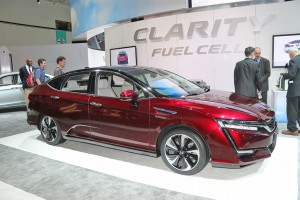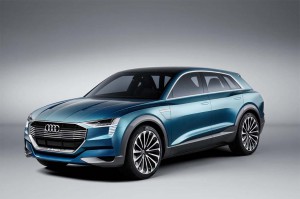Fuel-cell cars are little more than expensive props used by automakers to dodge increasingly tough fuel-economy regulations and emission standards, declared a senior executive from the Tesla Motor Co.
Diarmuid O’Connell, Tesla’s Vice President of Corporate and Business Development, told the Automotive Press Association Friday, that fuel cell technology simply is not practical because it will require a huge investment in an entirely new infrastructure to provide the hydrogen gas those vehicles needed.
Electric vehicles are more practical because they do not require anywhere as much of a new investment in public infrastructure, argued O’Connell, noting that Tesla has supported an expansion of high-speed EV-charging capabilities off its own balance sheet.
“Fuel cell technology requires a large degree of public (financial) support in a way that EVs will never need because the infrastructure is already available in every building and practically in every room of every building,” said O’Connell, adding that instead of fuel cell vehicles carmakers should invest in building EVs.
“We want more competition,” said O’Connell, cattily adding that the other EVs now available are rather boring and unattractive.
(Reborn Karma to get help under the hood from BMW for old Fisker plug-in hybrid. Click Here to learn more.)
O’Connell’s criticism of fuel-cell technology echoed the long-standing position of Tesla founder Elon Musk, who has said on several occasions that he doesn’t believe fuel cells will ever be practical. Musk often refers to them as “fool cells.”
But hydrogen cars have some powerful supporters. Hyundai put its first fuel-cell vehicle, a version of its Tucson SUV, on sale last year. Toyota is just launching its Mirai model and Honda showed off the new Clarity Fuel-Cell Vehicle at the L.A. Auto Show this week. It will begin selling the Clarity next year.
There is validity to at least some of O’Connell’s claims. Automakers receive both state and federal credits for marketing hydrogen vehicles. Those can be used to effectively boost the average mileage of a company’s conventionally powered fleet of products. California, in particular, also requires major automotive manufacturers to produce a minimum number of so-called zero-emission vehicles, or ZEVS, or be blocked from selling any products in the states.
But automakers get similar credits – and help meet ZEV rules – with electric vehicles. Tesla, in fact, has generated tens of millions of dollars to help offset its years of red ink by selling some of the credits it gets for building EVs to other carmakers. So, it has benefited from some of the same loopholes.
Electric vehicles, Tesla claims, are ultimately the best way to reduce consumption of petroleum and lower CO2 emissions in the transportation sector. But that topic generates plenty of debate within the automotive and environmental communities.
(Honda planning to add plug-in, EV versions of its new Clarity fuel-cell vehicle. Click Here for more.)
During his Detroit speech, Tesla’s O’Connell also challenged automakers to end their substantial lobbying effort now underway to derail tougher fuel-economy and greenhouse gas emission standards and instead spend the money on the engineering needed to meet the new rules.
The so-call mid-term review in which the EPA has promised to reconsider the progress towards the 54.5 miles per gallon fuel-economy standard set for 2025 is simply being used as dodge for the industry to water down the regulations, the Tesla exec argued.
Car makers did the same thing in the mid-1980s, when after meeting the 27.5 mpg standard, they delayed the imposition of tougher fuel-economy regulations for an additional 16 years.
The “unpriced externalities” or the damage done by the unchecked use of carbon fuels is far too great now to allow that to happen, said O’Connell, contending “There is no good technical reason why (carmakers) cannot meet the standard.”
O’Connell also said Tesla plans to unveil its next vehicle, the Tesla Model 3, next March and the new, lower-priced model will be on the road by 2017.
Tesla isn’t the only maker investing in battery power, in fact. At the L.A. Auto Show Audi, for one, estimated plug-based models will account for 20 to 25% of its U.S. sales by 2025.
(Click Here for more on Audi’s ambitious EV plans.)
But some makers, notably Toyota, contend that batteries are simply too expensive, inefficient and unreliable and that alternatives, such as hydrogen power, make better sense long-term.
(Paul A. Eisenstein contributed to this report.)




I have to agree with Tesla here – hydrogen cars are not the way. There is a FAR better likelihood that science will overcome battery storage limitations before solving Hydrogen storage issues.
Hydrogen is clean, but it doesn’t store well, or easily. My bet is on electrics.
There has been no issues with hydrogen storage over the past 5 years while the government has run field testing by bus and truck fleets. Tesla is hoping they can dupe consumers long enough to convert to hydrogen or become a bad memory. Hydrogen refilling stations are easy to implement and refilling a vehicle typically only takes five minutes. All the battery tech in the world is not going to allow a 100% battery recharge in 5 minutes if and when a traveler can find a recharging system on whatever roadway they are traveling. Hydrogen refilling stations could be in place at 50% of major roadway gas stations in a couple year’s time if free enterprise viewed it as a profit center. It will take higher hydrogen car production however before a large refilling infrastructure will be created.